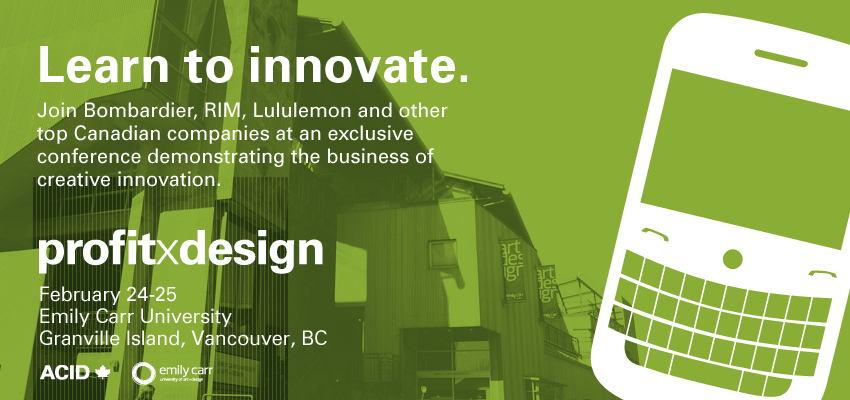 The good folks behind Profit By Design generously invited me to attend their conference at Emily Carr University of Art and Design (ECUAD) last weekend, in my emerging role as the “something or other” at the Sauder d.studio.** The two-day event featured a series of presentations and panels focused mainly on product and industrial design. It was a good chance for me to rub elbows with some of the stalwarts in these fields from B.C. and the rest of the country.
The good folks behind Profit By Design generously invited me to attend their conference at Emily Carr University of Art and Design (ECUAD) last weekend, in my emerging role as the “something or other” at the Sauder d.studio.** The two-day event featured a series of presentations and panels focused mainly on product and industrial design. It was a good chance for me to rub elbows with some of the stalwarts in these fields from B.C. and the rest of the country.
It was no surprise that the theme of most sessions centred around the value-added to business by design processes and practices. Everyone there agreed that design is a good thing for business.
What was a surprise was that few have invested in actually measuring the ROI of design (at least in Canada). That is Problem Number One. We need to show how we add value if we want clients to pony up for our services.
Problem Number Two? The culture of design. Apparently, “design club” is like fight club. First rule? Don’t talk about design club. Because the bean counters and senior managers already think we’re weird and we don’t really want them to know what we do in our black box studios. That sort of makes sense until we get to —
Problem Number Three. Lack of design literacy. Potential clients and funders don’t know what design is, how it works, or how it adds value. We spend too much time and energy educating them, just to get them to buy into our services.
So, who can spot the real problem here?
We are our own worst enemies. As long as we keep design club secret, our industry will struggle in obscurity. This became one of the key subjects of the conference’s final event – an invitation-only round table to draft a national innovation strategy. This is where Problem Number Four showed up. We keep trying to nail the perceived problem of lack of government support with the same hammer, by asking the feds for money to discuss the problem. I heard stories about previous initiatives that sounded exactly like the session I was sitting in – and they had all failed.
The irony wasn’t lost on me. Here was a room full of talented and senior designers, who all have years of experience in using decision processes to solve complex problems and foster innovation – and they couldn’t see that they were stuck in a pattern loop. To drive a national innovation agenda, we need to apply our expertise and design processes to innovate a NEW way forward.
For many in the room, one of the obvious solutions is a plan to raise design literacy across Canadian sectors – particularly among business people. What happy news for the d.studio at Sauder – we’re on the right track with our focus on design education! In fact, in the few days that have passed since the conference, requests for information about our programs and services continue to pour in.
And that, my friends, is the best kind of problem to have!
** We’re developing a new role for me in the d.studio. Best suggestion for my new title gets a Purdy’s Gift Box!!